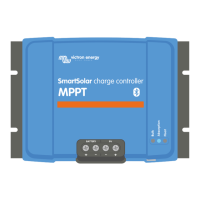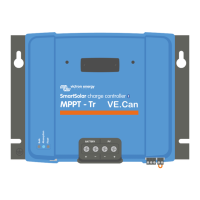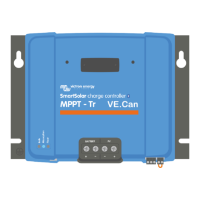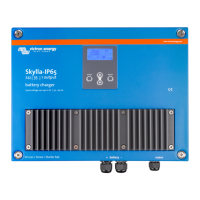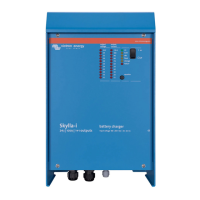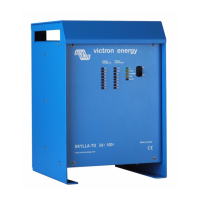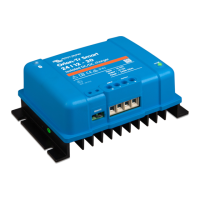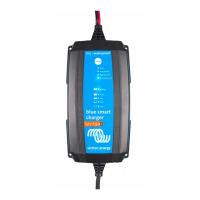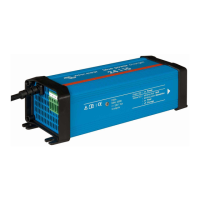
Do you have a question about the Victron energy SmartSolar MPPT 150/70 and is the answer not in the manual?
| Model | SmartSolar MPPT 150/70 |
|---|---|
| Category | Battery Charger |
| Type | MPPT Solar Charge Controller |
| Maximum PV Input Voltage | 150 V |
| Maximum Charge Current | 70 A |
| Efficiency | 98% |
| Battery Voltage | 12/24/36/48 V Auto Select |
| Communication | Bluetooth |
| Enclosure Protection | IP43 |
| Operating Temperature | -30°C to +60°C |
| Maximum PV Power | 1000 W |
| Protection | Over temperature |
| Self Consumption | 10 mA |
General safety instructions for installation and operation.
Guidelines for safe and proper electrical wiring procedures.
Explanation of symbols found on the solar charger enclosure.
Regulatory compliance information for FCC and Industry Canada.
Details on voltage and current ratings for battery and PV.
Description of the two available PV terminal models: TR and MC4.
How the charger automatically detects system voltage.
Explanation of the MPPT tracking algorithm for optimal yield.
Information on the charger's high conversion efficiency.
Details on the charger's built-in electronic protection features.
Overview of the VictronConnect app's capabilities for monitoring and control.
Options for displaying charger information and status.
Functionality and uses of the VE.Direct communication port.
Description of the VE.Can ports for network communication.
Features related to the virtual load output functionality.
Explanation of the 3-stage battery charging process.
How temperature sensing affects battery charging.
How voltage sensing compensates for cable losses.
Methods for remotely controlling the charger's power.
Functionality of the programmable relay for custom triggers.
Information about the optional WireBox for terminal protection.
Guidelines for physically mounting the solar charger.
Requirements for battery protection and connection.
Requirements for PV array configuration and connection.
Proper grounding procedures for safety and system integrity.
Visual guide to the charger's connection terminals.
Step-by-step guide for making electrical connections.
Details on using VE.Can ports for networking.
Instructions for installing the SmartSolar Control display.
Instructions for connecting the MPPT Control display.
Overview of methods for configuring charger settings.
Configuring settings using the VictronConnect mobile application.
Selecting pre-programmed charge algorithms using the rotary switch.
Adjusting settings via the optional SmartSolar Control display.
Adjusting settings via the optional MPPT Control display.
Detailed explanation of all user-configurable charger settings.
Configuration options for battery parameters and charging.
Settings for controlling the load output functionality.
Configuration options for the programmable relay.
Settings for controlling street lighting based on sunset/sunrise.
Configuration of the TX port for output signals.
Configuration of the RX port for input signals.
Procedure for checking and updating the charger's firmware.
How to manage the Bluetooth communication feature.
Setting up and managing VE.Smart Networks.
Step-by-step guide to create a VE.Smart Network.
How the solar charger powers up and becomes operational.
Explanation of the battery charging process and stages.
How automatic equalization works for battery maintenance.
Recommended settings for Lithium Iron Phosphate (LiFePo4) batteries.
Steps for safely shutting down and restarting the charger.
Information regarding the maintenance requirements of the charger.
Understanding the status indicators via the charger's LEDs.
Information on how error codes are displayed and where to find meanings.
Using the VictronConnect app for live data and history.
Details shown on the VictronConnect app's status screen.
Accessing and interpreting historical charging data.
How the app reports active and historical errors.
Monitoring through GX devices and the VRM portal.
Visual inspection for physical damage.
Steps to diagnose an unresponsive solar charger.
Reasons and troubleshooting for the charger being off.
Behaviour when charger is controlled by external systems.
Scenarios where charger is active, but batteries aren't charging.
Reasons and checks for undercharged batteries.
Causes and checks for overcharging batteries.
Reasons for the charger not reaching maximum output.
Troubleshooting problems with device communication.
Addressing various other troubleshooting topics.
Introduction to error codes and their meanings.
Technical specs for 150/70, 150/85, 150/100 models.
Technical specs for 250/70, 250/85, 250/100 models.
Visual representations of the charger's physical dimensions.
